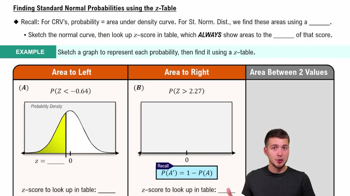Interpreting Normal Quantile Plots Which of the following normal quantile plots appear to represent data from a population having a normal distribution? Explain.
Table of contents
- 1. Intro to Stats and Collecting Data1h 14m
- 2. Describing Data with Tables and Graphs1h 55m
- 3. Describing Data Numerically2h 5m
- 4. Probability2h 16m
- 5. Binomial Distribution & Discrete Random Variables3h 6m
- 6. Normal Distribution and Continuous Random Variables2h 11m
- 7. Sampling Distributions & Confidence Intervals: Mean3h 23m
- Sampling Distribution of the Sample Mean and Central Limit Theorem19m
- Distribution of Sample Mean - Excel23m
- Introduction to Confidence Intervals15m
- Confidence Intervals for Population Mean1h 18m
- Determining the Minimum Sample Size Required12m
- Finding Probabilities and T Critical Values - Excel28m
- Confidence Intervals for Population Means - Excel25m
- 8. Sampling Distributions & Confidence Intervals: Proportion1h 12m
- 9. Hypothesis Testing for One Sample3h 29m
- 10. Hypothesis Testing for Two Samples4h 50m
- Two Proportions1h 13m
- Two Proportions Hypothesis Test - Excel28m
- Two Means - Unknown, Unequal Variance1h 3m
- Two Means - Unknown Variances Hypothesis Test - Excel12m
- Two Means - Unknown, Equal Variance15m
- Two Means - Unknown, Equal Variances Hypothesis Test - Excel9m
- Two Means - Known Variance12m
- Two Means - Sigma Known Hypothesis Test - Excel21m
- Two Means - Matched Pairs (Dependent Samples)42m
- Matched Pairs Hypothesis Test - Excel12m
- 11. Correlation1h 6m
- 12. Regression1h 50m
- 13. Chi-Square Tests & Goodness of Fit1h 57m
- 14. ANOVA1h 57m
6. Normal Distribution and Continuous Random Variables
Standard Normal Distribution
Problem 31
Textbook Question
Aircraft Seat Width Engineers want to design seats in commercial aircraft so that they are wide enough to fit 99% of all adults. (Accommodating 100% of adults would require very wide seats that would be much too expensive.) Assume adults have hip widths that are normally distributed with a mean of 14.3 in. and a standard deviation of 0.9 in. (based on data from Applied Ergonomics). Find P99. That is, find the hip width for adults that separates the smallest 99% from the largest 1%.
 Verified step by step guidance
Verified step by step guidance1
Step 1: Understand the problem. We are tasked with finding the hip width (P99) that separates the smallest 99% of adults from the largest 1%. This involves using the properties of the normal distribution and identifying the z-score corresponding to the 99th percentile.
Step 2: Recall the formula for converting a z-score to a value in a normal distribution: \( x = \mu + z \cdot \sigma \), where \( \mu \) is the mean, \( \sigma \) is the standard deviation, \( z \) is the z-score, and \( x \) is the value we are solving for.
Step 3: Determine the z-score for the 99th percentile. Using a z-score table or statistical software, find the z-score corresponding to a cumulative probability of 0.99. This z-score is approximately \( z = 2.33 \).
Step 4: Plug the values into the formula. Substitute \( \mu = 14.3 \), \( \sigma = 0.9 \), and \( z = 2.33 \) into the formula \( x = \mu + z \cdot \sigma \). This will give the hip width \( x \) that separates the smallest 99% of adults from the largest 1%.
Step 5: Perform the calculation. Multiply \( z \cdot \sigma \) and add the result to \( \mu \). This will yield the value of \( x \), which is the desired hip width (P99).
 Verified video answer for a similar problem:
Verified video answer for a similar problem:This video solution was recommended by our tutors as helpful for the problem above
Video duration:
3mPlay a video:
Was this helpful?
Key Concepts
Here are the essential concepts you must grasp in order to answer the question correctly.
Normal Distribution
Normal distribution is a probability distribution that is symmetric about the mean, depicting that data near the mean are more frequent in occurrence than data far from the mean. In this context, adult hip widths are assumed to follow a normal distribution, characterized by its mean (14.3 inches) and standard deviation (0.9 inches). Understanding this distribution is crucial for determining percentiles, such as P99.
Recommended video:
Guided course

Finding Standard Normal Probabilities using z-Table
Percentiles
A percentile is a measure used in statistics to indicate the value below which a given percentage of observations fall. For example, P99 refers to the hip width below which 99% of adults fall, meaning only 1% have a hip width greater than this value. Calculating percentiles involves using the properties of the normal distribution, specifically the z-score.
Z-Score
A z-score is a statistical measurement that describes a value's relationship to the mean of a group of values, expressed in terms of standard deviations. It is calculated by subtracting the mean from the value and then dividing by the standard deviation. In this problem, the z-score corresponding to P99 will help determine the specific hip width that separates the smallest 99% from the largest 1% of adults.
Recommended video:
Guided course

Z-Scores From Given Probability - TI-84 (CE) Calculator

 9:47m
9:47mWatch next
Master Finding Standard Normal Probabilities using z-Table with a bite sized video explanation from Patrick
Start learningRelated Videos
Related Practice
Textbook Question
